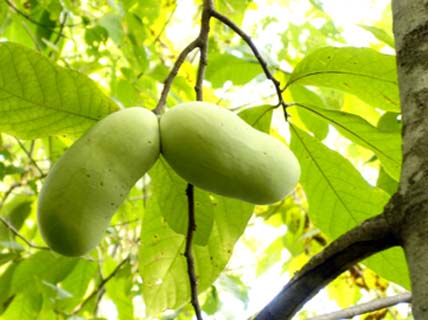Interactions
Eurytides marcellus has a few different defense mechanisms to protect itself from predators. One of these mechanisms is where it expels butyric acids out of its osmaterial glands that protect itself from small predators like ants (Martin et al. 1999). However, this does not protect itself from larger predators. The osmeterium is a flexible defense gland in the shape of a fork which can be found protruding from the area between the prothorax and head. This is found in all swallowtail butterflies in the family Papilionidae (Chattopadhyay 2011).
 E.
marcellus feeds on
paw paw trees for protection because they
provide an additional defense mechanism, which helps protect against
larger predators such as birds. From feeding on paw paw trees while
in the larval stage it provides annonaceous acetogenins that are
sequestered and maintained (Martin et al. 1999). Few herbivores
feed on the paw paw tree because of the the foilage and twigs are
toxic and the tree produces acetogenins, which are also harmful
(Martin et al. 1999). The zebra swallowtail feed on them to utilize
these factors to their advantage by protecting against large
predators (Martin et al. 1999). Due to all of these different
defense mechanisms, the E. marcellus has very few
organisms that are natural predators.
E.
marcellus feeds on
paw paw trees for protection because they
provide an additional defense mechanism, which helps protect against
larger predators such as birds. From feeding on paw paw trees while
in the larval stage it provides annonaceous acetogenins that are
sequestered and maintained (Martin et al. 1999). Few herbivores
feed on the paw paw tree because of the the foilage and twigs are
toxic and the tree produces acetogenins, which are also harmful
(Martin et al. 1999). The zebra swallowtail feed on them to utilize
these factors to their advantage by protecting against large
predators (Martin et al. 1999). Due to all of these different
defense mechanisms, the E. marcellus has very few
organisms that are natural predators.
The zebra swallowtail also lays eggs on the paw paw tree. However, the females are very picky about what paw paw trees that they lay their eggs on. Before they will lay eggs on the trees, zebra swallowtails evaluate the trees not by touching them, but by circling around the plant. Females preferably lay eggs on the paw paw trees with the youngest leaves (Dammon and Feeny 1988). The soft, young leaves are the most suitable for larva development (Sime 2005).
They are in competition with the Talponia plummeriana, a small mouth larva, that digs through the flowers' fleshy tissues of the paw paw tress causing the flowers to drop and wither (Kentucky State University Cooperative Extension Program 2009). The two insects are in competition for the same thing; the paw paw tree. While each insect uses different parts of the tree, both can be detrimental to the tree's overall health and are therefore in competition for the use of the trees.
 The zebra swallowtail
butterfly adult feeds on the nectar of some flowers like blackberry,
redbud, bugloss, verbena,
blueberry, and common milkweed
(Butterflies and Moths of North America 1977). This is a
mutualistic relationship between the zebra swallowtail butterfly and
all of these plants because in exchange for feeding off of the
nectar of these plants, the zebra swallowtail butterfly helps to
pollinate the plants. This occurs because as the butterfly uses is
proboscis to get at the nectar that is deep inside the flower,
pollen grains attach themselves all over the body of the butterfly.
These pollen grains fall off or are brushed off when the butterfly feeds
on the nectar of nearby plants, thus fertilizing the next plant.
The zebra swallowtail
butterfly adult feeds on the nectar of some flowers like blackberry,
redbud, bugloss, verbena,
blueberry, and common milkweed
(Butterflies and Moths of North America 1977). This is a
mutualistic relationship between the zebra swallowtail butterfly and
all of these plants because in exchange for feeding off of the
nectar of these plants, the zebra swallowtail butterfly helps to
pollinate the plants. This occurs because as the butterfly uses is
proboscis to get at the nectar that is deep inside the flower,
pollen grains attach themselves all over the body of the butterfly.
These pollen grains fall off or are brushed off when the butterfly feeds
on the nectar of nearby plants, thus fertilizing the next plant.
The zebra swallowtail butterfly is a primary consumer because its primary larval food source are the leaves of the paw paw tree (Martin et al. 1999). In the adult form, the butterfly of the E. marcellus feeds off the nectar of the aforementioned plants; therefore, remaining a primary consumer even throughout adulthood (Butterflies and Moths of North America 1977). E. marcellus also does not serve as a host for any other organisms. The zebra swallowtail butterfly is not known to have any effects on humans or have any uses for humans (Animal Diversity Web 2001).
.jpg)